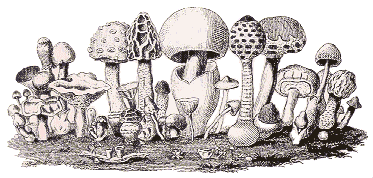Recently I was trying to key out a Hebeloma species and came across the terms deeply emarginate, narrowly adnate and adnate to slightly emarginate. Gill attachment is considered to be an important character for identifying fungi and is often referred to in keys by eminent mycologists, for example Watling [1] and in Nordic Macromycetes [2] however some of the terminology used to describe the different types of attachment can be confusing to the amateur field mycologist.
Many field guides give some details of gill attachment often with a few simple diagrams. The BMS booklet ‘Guide for the Beginner’ [3] has diagrams plus a short description covering most types of attachment. Thomas Læssøe in his book Pilze [4] uses photographs of sectioned caps to illustrate gill attachment. Useful information is also available on the Internet. For example, the Illinois Mycological Association has produced a very useful Web page on this topic [5].
The term "free gills" is fairly straightforward and is characteristic of species belonging to the genera Agaricus, Amanita, Lepiota, Pluteus and Volvariella. However one should be aware that in older specimens gills that were originally attached to the stem sometimes secede or pull away giving the appearance of being free. Therefore it is important to examine more that one fruit body and particularly younger specimens if available. Decurrent gills characteristic of many Clitocybe species and the decurrent vein-like folds of Cantharellus cibarius are also easily recognised. Most confusion arises with the narrowly attached gills (adnexed, emarginate, and sinuate). The literature is not always helpful here. Some authors do not differentiate between emarginate and sinuate [6] while others use the term notched gills instead. Definitions of sinuate that I have come across include gill edge abruptly notched, gill edge S-shaped and gill edge having a concave indentation.
Many of the terms used to describe gill attachment in fungi are derived from botanical descriptions of vascular plants and looking at various on-line dictionaries I came across the following definitions:
- adnate - grown together or attached
- adnexed - annexed or touching, but not attached
- emarginate - leaf having a notched edge (emarginare = to deprive of its edge)
- sinuate - margin of the leaf forms a wavy line (sinuatus = curved)
On the basis of these investigations I conclude that emarginate should be used to refer to gills that are notched (suddenly become much shallower as if a piece of gill has been removed) just before attaching to the stem whereas sinuate gills curve back down the stem before attachment. I have attempted to define the terms used to describe gill attachment more explicitly in the glossary based on the references included with this article. Hopefully, this will help to clear up some of the misunderstandings in this area.
Glossary of terms relating to gill attachment
adnate - gills broadly attached/joined to stipe for most of their depth; proximal end not notched.
adnexed - gills narrowly attached/tapering toward stem so that their attachment is almost free.
decurrent - gills descending markedly down stem (subdecurrent - gills descending down stem only a short distance).
emarginate - gills notched just before attaching to the stem.
free – gills not attached to stem (remote - ending at some distance from stem).
seceding – gills at first attached to the stem but later breaking away from it.
sinuate - gills having a concave indentation before attaching to the stem.
References
[1] Watling, R. (1973). Hulton Group Keys – Identification of the Larger Fungi (ed. A. R. Kenney). Hulton Educational Publications Ltd., Amersham, UK.
[2] Nordic Macromycetes Vol. 2 (1992). Nordsvamp, Copenhagen, Denmark.
[3] Marriott, J.V.R. (1993). Guides for the Amateur Mycologist: 1. Guide for the beginner. British Mycological Society.
[4] Læssøe, T. (1999). Pilze. Urania-Ravensburger, Berlin.
[5] Page on Gill Attachment from Illinois Mycological Association Web site: first visited 09/02/2003; last visited 15/10/2003.
[6] Hawksworth, D.L. et al. (1995). Ainsworth & Bisby’s Dictionary of the Fungi (eighth edition). CAB International, Oxon, UK.
